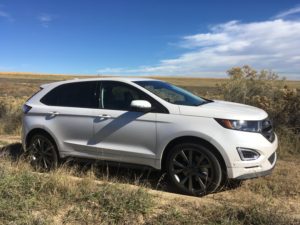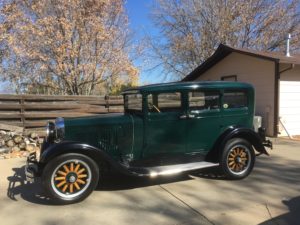
The Sport version of the 2017 Edge puts Ford among the top tier of two-row midsize SUV/crossovers.
With a firmed-up suspension tied to 21-inch wheels, EcoBoost under the hood, all-wheel drive and a huge cargo area at the rear, the Edge is attractive as a family hauler.
Among other two-row competitors are Jeep Grand Cherokee, Nissan Murano, Kia Sorento, Hyundai Santa Fe Sport, GMC Acadia All-Terrain, Volkswagen Touareg.
Only the Jeep Grand Cherokee Hemi V-8 has more power than the Edge Sport. The Ford’s 2.7-liter V-6 EcoBoost V-6 delivers 315 horsepower and 350 lb.-ft. of torque, and at midrange would give even the Hemi a run for its money.
In addition to its turbo power, the 2.7 EcoBoost carries an EPA fuel-mileage estimate of 17 to 24. With about three-fourths of my 450 miles of driving on the highway, the Edge averaged 22.5 miles per gallon overall.
The Edge Sport has a relatively wide track of almost 65 inches and rides on Pirelli Scorpion 265/40R21 tires. Its wheelbase is 112.2 inches, overall length 188 inches and curb weight 4,080 pounds.
It perfectly parked itself very rapidly into a parallel spot with its active park assist system. Ford was one of the first to introduce this feature a few years ago and appears to have improved upon it. With my hands off the steering wheel, the system quickly backed the Edge into position along the curb.
A swing of my foot beneath the rear bumper opened the rear liftgate automatically. Its cargo space is one of the roomiest at 39.2 cubic feet; fold the rear seats and the open area expands to 73 cubic feet.
Among its many safety features are inflatable seatbelts for the rear seats, in which, in a crash, a tubular airbag unzips from the seams of the seatbelts across the occupant’s chest.
The beefed-up Edge Sport becomes somewhat pricey; the model I reviewed carried a sticker price of $47,575. It included voice-activated touchscreen navigation, remote start, heated and cooled front seats and heated rear seats, lane-keeping system, rain-sensing wipers and adaptive cruise/collision warning.

The Edge one morning carried Jan and me from out east in Aurora across the metro area as far as U.S. 287, then north to Berthoud, where we joined Don and Nadine Cassata and Ed Hart in looking over a 1928 Dodge Victory Six sedan.
The Dodge belonged to Nadine’s father, the late Maurice Nelson, and the Cassatas have given some thought to selling it. I heard it run; it sounded good and smooth. It is a flathead-6, the engine design long-used by Dodge until 1960, when it introduced the Slant-6.